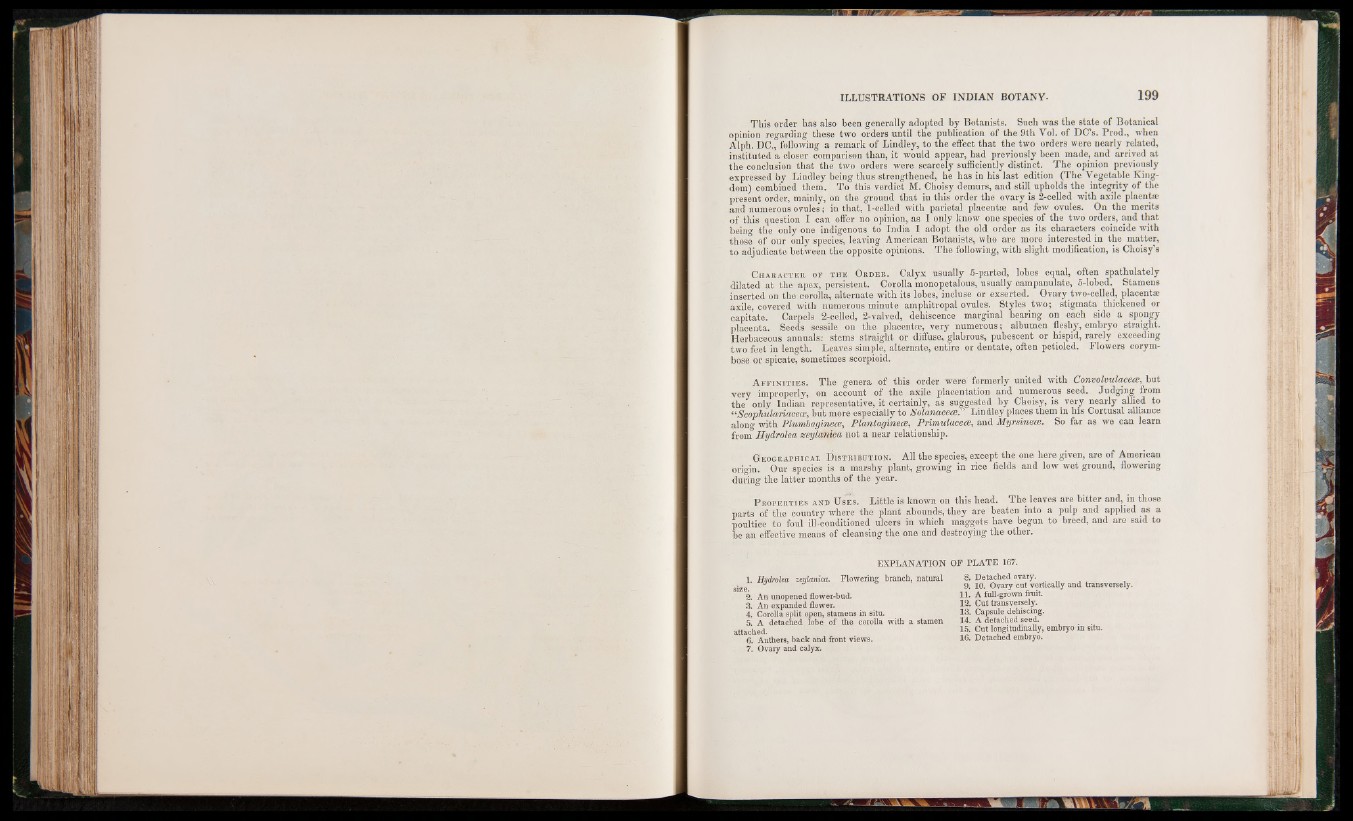
ILLUSTRATIONS OF INDIAN BOTANY. 199
This order has also been generally adopted by Botanists. Such was the state of Botanical
opinion regarding these two orders until the publication of the 9th Vol. of DC’s. Prod., when
Alph. DC., following a remark of Lindley, to the eifect that the two orders were nearly related,
instituted a closer comparison than, it would appear, had previously been made, and arrived at
the conclusion that the two orders were scarcely sufficiently distinct. The opinion previously
expressed by Lindley being thus strengthened, he has in his last edition (The Vegetable Kingdom)
combined them. To this verdict M. Choisy demurs, and still upholds the integrity of the
present order, mainly, on the ground that in this order the ovary is 2-celled with axile plaentae
and numerous ovules; in that, 1-celled with parietal placentae and few ovules. On the merits
of this question I can offer no opinion, as I only know one species of the two orders, and that
being the only one indigenous to India I adopt the old order as its characters coincide with
those of our only species, leaving American Botanists, who are more interested in the matter,
to adjudicate between the opposite opinions. The following, with slight modification, is Choisy’s
C h a r a c t e r of t h e O r d e r . Calyx usually 5-parted, lohes equal, often spathulately
dilated at the apex, persistent. Corolla monopetalous, usually campanulate, 5-lobed. Stamens
inserted on the corolla, alternate with its lobes, incluse or exserted. Ovary two-celled, placentae
axile, covered with numerous minute amphitropal ovules. Styles two; stigmata^ thickened or
capitate. Carpels 2-celled, 2-valved, dehiscence marginal bearing on each side a spongy
placenta. Seeds sessile on the placentae, very numerous; albumen fleshy, embryo straight.
Herbaceous annuals: stems straight or diffuse, glabrous, pubescent or hispid, rarely exceeding
two feet in length. Leaves simple, alternate, entire or dentate, often petioled. Flowers corymbose
or spicate, sometimes scorpioid.
A f f in i t i e s . The genera of this order were' formerly united with Convolmlacece, but
very improperly, on account of the axile placentation and numerous seed. Judging from
the only Indian representative, it certainly, as suggested by Choisy, is _ very nearly allied to
“Scophulariacece, but more especially to Solanacece.” Lindley places them in his Cortusal alliance
along with Plumbaginece, Plantaginece, Primulacece, and Myrsinece. So far as we can learn
from Hydrolea xeylanica not a near relationship.
G e o o r a ph ic a l D is t r ib u t io n . All the species, except the one here given, are of American
origin. Onr species is a marshy plant, growing in rice fields and low wet ground, flowering
during the latter months of the year.
P r o p e r t ie s a n d U s e s . Little is known on this head. The leaves are bitter and, in those
parts of the country where the plant abounds, they are beaten into a pulp and applied m a
poultice to foul ill-conditioned ulcers in which maggots have begun to breed, and are said to
be an effective means of cleansing the one and destroying the other.
EXPLANATION OF PLATE 167.
1. HydroUa zeylanica. Flowering branch, natural
size.2
. An unopened flower-bud.
3. An expanded flower.
4. Corolla split open, stamens in situ.
5. A detached lobe of the corolla with a stamen
attached.
6. Anthers, back and front views.
7. Ovary and calyx.
8. Detached ovary.
9. 10. Ovary cut vertically and transversely.
11. A full-grown fruit.
12. Cut transversely.
13. Capsule dehiscing.
14. A detached seed.
15. Cut longitudinally, embryo in situ.
16. Detached embryo.